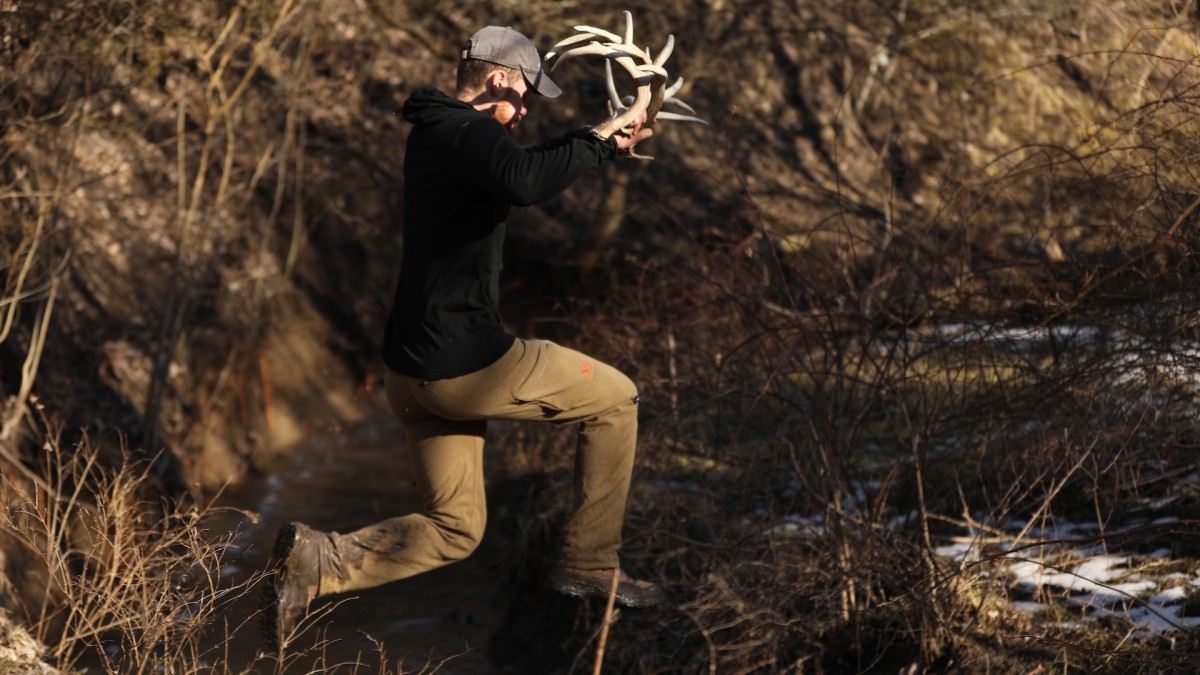
Any time spent in the woods is valuable, but let's talk about the target goal of shed antlers. Days filled with work meetings aren't always a lost cause. A few short minutes could be all you need to grab a few antlers this spring.
Shed hunting doesn't always need to take place where you want to hunt. It's beneficial to zero in on areas known for wintering bucks. A little map reading and an evening drive to learn local buck habits will go far. Remember your goal in these places; you don't need to worry about finding a tree to climb. Or whether there is enough deer sign in the area to make it a worthwhile hunt.
Search for pinch points and funnels where you can do a quick scan and move on to the next. Put new hunting spots or planning strategies aside for now. When you only have time to pick up a few pieces of bone, look in these places for some of the most consistent antler finds.
Power Line Cuts
Three things make power lines an antler gold mine: edges, historical deer trails, and constant new growth. After a brush mower runs through a power line, the ground won't stay bare for long. Briars and weeds will cover the bare ground in a few weeks of warm spring or summer days. The density of cover that a power line cut provides all year is inviting to wintering deer. Even more appealing is that most of it is edible greenery.
Power lines are great for a 15-minute to a 1-hour shed hunt. They are often close enough to a road to allow a quick peek. Antlers are typically found along their edges, but don't skip the bottom! Power lines that run across a valley or draw often have an erosion ditch or creek. Bucks traveling these funnels are prone to dropping antlers.
Creeks
A creek is a hotspot for a quick shed hunt. Look for creeks with defined travel borders, crossings, and bedding. Because of the soft ground around a creek, deer trails are more visible. More jostling happens when bucks hop across or crawl up a steep bank at creek crossings. That movement can often be enough to knock a few antlers loose. Bucks also bed along brushy spots where a creek bends. They use the edges as travel funnels from bed-to-bed or bed-to-food locations. The consistent use makes creeks a valuable component for finding shed antlers.
Pay close attention to the muddy trails deer make while crossing the creek. Look over them once and then look again closely. If there is a well-traveled deer trail bordering the creek, it's always worth a walk. An antler trampled into the mud is tough to see. Also, look into the water for antlers that drop in the middle of the creek.
Don't dismiss the creeks beside a local soccer field or rail trail. While they may not be ideal hunting locations, deer are still traveling through them and potentially dropping an antler. And check creeks more than once during the spring. Bucks feel comfortable there, so there’s a good chance of the area reloading with antlers. Scooping a few sheds before your nine-to-five shift is an excellent start to your day.
Buffer Strips
Buffer strips usually describe brush or grass strips extending into a crop field, but they can occur anywhere. Examples of other buffer strips include a slim section of a clear cut under the open hardwoods, a brushy corner of a creek (see the creek theme?), or a larger version of a buffer strip like a fence row.
Bucks love these strips because they lengthen their time inside cover while traveling. There is more concealment and security in cover like this, and that cover has the potential to knock some antlers loose. Bucks also stage (become active from a safe position) and bed in buffer strips before exposing themselves to an open area in the dark.
Wrap Up
It might be a municipal park, refuge, or highly traveled trail where hiking is legal. The point is that there are places to go in your spare time to look for shed antlers. It may not be an area where you can hunt, but anything you can do to learn about deer movement and behavior can help you understand them in other areas.
A few more parting tips: check your local quick spots up to four times between the last day of February and mid-April. Keep a spare set of binoculars in your vehicle. You never know when you'll have a minute to glass a field. If you think you've peered into all the cover, look again.







Conversation